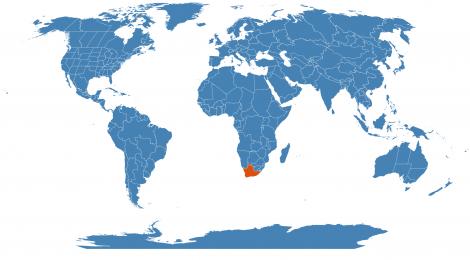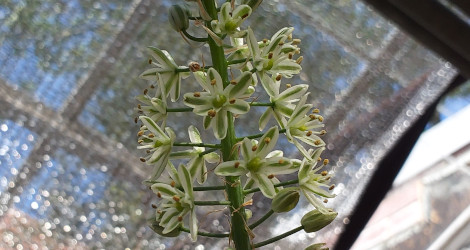Accession Data:
Ornithogalum thyrsoides Jacq.
- Common Name: Cape Chincherinchee
- Family: Asparagaceae Juss.
- Country of Origin: South Africa - northern and western Cape

- Habitat: sandy flats in winter rainfall areas
- Description: Ornithogalum thyrsoides is a bulbous geophyte, 200 to 500 mm tall, developing large rounded bulbs that are dormant in the summer months. The plant has few (5-7) fleshy leaves that die back after flowering. Leaves range from 150 to 300 mm in length and 5 to 15 mm in width, are lance-shaped, smooth and soft-textured.3
Flower stalks are leafless and produce either a tight cluster of 30-50 flowers in a raceme or a loose corymb of few (5-20) flowers with flowers reaching almost the same height. The flowers are bowl-shaped and are supported by a large green bract about the length of pedicels in open flowers. Flowers are white or creamy-white, usually with a brown or green centre that fades with age. They appear from late spring to mid summer (October to February), are long lasting and also phototropic (bending in response to light). The capsule is spindle-shaped and thin walled, splitting longitudinally to expose black, shiny, variously shaped seeds.3
- Uses: Chincherinchee is usually grown as a source of long lasting cut flowers.
- Culture: The plant does not have sufficient cold tolerance to be left in the ground through the winter. The white flowers are produced on one-foot stems in early summer. When the flowers are cut and cared for properly, they can last for months. At the end of the growing season dig the bulbs and store them as you would other tender bulbs. Chincherinchee may also be grown in pots.
- USDA Zone: 7a-10b
Accession Data:
- Accession # 199500175
- Source: Chiltern '95
- Accession Date: 12-14-1995
- Bench: 2109 - MED:Fynbos A
- Currently: active - healthy
- Qty: 2 confirmed on 02-11-2025
Classification:
- Division: Magnoliophyta
- Class: Liliopsida
- SubClass: monocots
- Order: Asparagales
- SubOrder:
- Family: Asparagaceae
- SubFamily: Scilloideae
- Tribe: Ornithogaleae
- SubTribe:
Flowering Data:
This accession has been observed in bloom on:| Year | Jan | Feb | Mar | Apr | May | Jun | Jul | Aug | Sep | Oct | Nov | Dec | ||||||||||||||||||||||||||||||||||||||||
|---|---|---|---|---|---|---|---|---|---|---|---|---|---|---|---|---|---|---|---|---|---|---|---|---|---|---|---|---|---|---|---|---|---|---|---|---|---|---|---|---|---|---|---|---|---|---|---|---|---|---|---|---|
| 2025 | ||||||||||||||||||||||||||||||||||||||||||||||||||||
| 2024 | ||||||||||||||||||||||||||||||||||||||||||||||||||||
| 2023 | ||||||||||||||||||||||||||||||||||||||||||||||||||||
| 2022 | ||||||||||||||||||||||||||||||||||||||||||||||||||||
| 2021 | ||||||||||||||||||||||||||||||||||||||||||||||||||||
| 2020 | ||||||||||||||||||||||||||||||||||||||||||||||||||||
| 2019 | ||||||||||||||||||||||||||||||||||||||||||||||||||||
| 2018 | ||||||||||||||||||||||||||||||||||||||||||||||||||||
| 2017 | ||||||||||||||||||||||||||||||||||||||||||||||||||||
| 2016 | ||||||||||||||||||||||||||||||||||||||||||||||||||||
| 2015 | ||||||||||||||||||||||||||||||||||||||||||||||||||||
| 2014 | ||||||||||||||||||||||||||||||||||||||||||||||||||||
| 2013 | ||||||||||||||||||||||||||||||||||||||||||||||||||||
| 2012 | ||||||||||||||||||||||||||||||||||||||||||||||||||||
| 2011 | ||||||||||||||||||||||||||||||||||||||||||||||||||||
| 2010 | ||||||||||||||||||||||||||||||||||||||||||||||||||||
| 2009 | ||||||||||||||||||||||||||||||||||||||||||||||||||||
| 2008 | ||||||||||||||||||||||||||||||||||||||||||||||||||||
| 2007 | ||||||||||||||||||||||||||||||||||||||||||||||||||||
| 2006 | ||||||||||||||||||||||||||||||||||||||||||||||||||||
| 2005 | ||||||||||||||||||||||||||||||||||||||||||||||||||||
References (internal):
- EEB Greenhouse Holdings native to: Cape Provinces /
References (external):
- The Plant List (2013). Version 1.1. Last accessed on Wednesday, 26 December, 2018.
- WCSP (2015). World Checklist of Selected Plant Families. Facilitated by the Royal Botanic Gardens, Kew. Last accessed on Wednesday, 26 December, 2018.
- Ornithogalum thyrsoides at PlantzAfrica. Last accessed Wednesday, 26 December, 2018.
- Ornithogalum thyrsoides at African Plants Database. Last accessed on Wednesday, 26 December, 2018.
- Angiosperm Phylogeny Website at MoBot. Last accessed on Tuesday, 03 December, 2019.
data regenerated on Thu, 24 Apr 2025 15:27:26 -0400 [bcm v4.0]
Images:

Additional images for this accession:
Click on thumbnails to enlargeCurrent Accessions in the Asparagaceae
Subfamily Agavoideae
Subfamily Agavoideae
Tribe Agaveae
- Agave americana


- Agave americana 'Marginata'

- Agave attenuata

- Agave cf parryi
- Agave cf stricta
- Agave cf. titanota
- Agave guiengola W/C

- Agave murpheyi

- Agave nizandensis

- Agave parrasana

- Agave parryi

- Agave polianthiflora

- Agave schidigera

- Agave sisalana


- Agave tequilana


- Agave victoriae-reginae

- Agave victoriae-reginae

- Beschorneria septentrionalis


- Furcraea foetida

- Hosta sieboldiana


- Hosta tsushimensis W/C

- Manfreda maculosa

- Polianthes tuberosa

- Yucca glauca

Subfamily Agavoideae
Tribe Anemarrheneae
Subfamily Agavoideae
Tribe Anthericeae
Subfamily Asparagoideae
Subfamily Lomandroideae
Tribe Arthropodium group
Subfamily Lomandroideae
Tribe Cordylineae
Subfamily Lomandroideae
Tribe Lomandreae
Subfamily Nolinoideae
Tribe Convallarieae
- Aspidistra elatior


- Aspidistra grandiflora W/C

- Aspidistra tonkinensis W/C

- Reineckea carnea

- Tupistra kressii W/C


- Tupistra urceolata W/C


Subfamily Nolinoideae
Tribe Dracaeneae
- Dracaena aethiopica

- Dracaena angolensis

- Dracaena angolensis

- Dracaena aubryana

- Dracaena draco

- Dracaena masoniana

- Dracaena parva

- Dracaena pethera var. pulchra

- Dracaena reflexa

- Dracaena reflexa var. angustifolia

- Dracaena singularis
- Dracaena spathulata W/C

- Dracaena spathulata W/C

- Dracaena trifasciata

- Dracaena trifasciata

Subfamily Nolinoideae
Tribe Eriospermeae
Subfamily Nolinoideae
Tribe Nolineae
Subfamily Nolinoideae
Tribe Ophiopogoneae
- Liriope muscari 'Variegata'

- Ophiopogon jaburan Argenteo-marginatus

- Ophiopogon japonicus


- Peliosanthes macrostegia W/C

Subfamily Nolinoideae
Tribe Rusceae
Subfamily Scilloideae
Tribe Hyacintheae
- Camassia quamash

- Hyacinthinae: Leopoldia longipes

- Hyacinthinae: Scilla peruviana

- Massoniinae: Drimiopsis botryoides


- Massoniinae: Drimiopsis maculata


- Massoniinae: Eucomis bicolor


- Massoniinae: Eucomis vandermerwei W/C


- Massoniinae: Lachenalia aloides

- Massoniinae: Lachenalia bulbifera


- Massoniinae: Lachenalia cf. longituba W/C

- Massoniinae: Lachenalia ensifolia


- Massoniinae: Lachenalia rubida

- Massoniinae: Lachenalia unifolia W/C

- Massoniinae: Lachenalia viridiflora


- Massoniinae: Ledebouria socialis

- Massoniinae: Massonia depressa W/C


- Massoniinae: Massonia pygmaea


- Massoniinae: Veltheimia bracteata


Subfamily Scilloideae
Tribe Ornithogaleae
- Albuca bracteata


- Albuca bracteata W/C


- Albuca concordiana W/C

- Albuca setosa W/C

- Albuca spiralis W/C

- Albuca tortuosa

- Albuca virens W/C

- Ornithogalum adseptentrionesvergentulum

- Albuca concordiana W/C

- Ornithogalum graminifolium W/C

- Ornithogalum hispidulum W/C

- Ornithogalum sardienii W/C


- Ornithogalum thyrsoides


Subfamily Scilloideae
Tribe Urgineeae
- Bowiea volubilis


- Bowiea volubilis ssp. gariepensis


- Bowiea volubilis ssp. volubilis

- Drimia haworthioides

- Drimia intricata

- Drimia platyphylla W/C


- Drimia sp. W/C
- Drimia uniflora W/C


 = indicates flowering in past 14 days
= indicates flowering in past 14 days
 = images available for this accession
= images available for this accession
 = map available for this accession
= map available for this accession
 = accession added within past 90 days
= accession added within past 90 days
